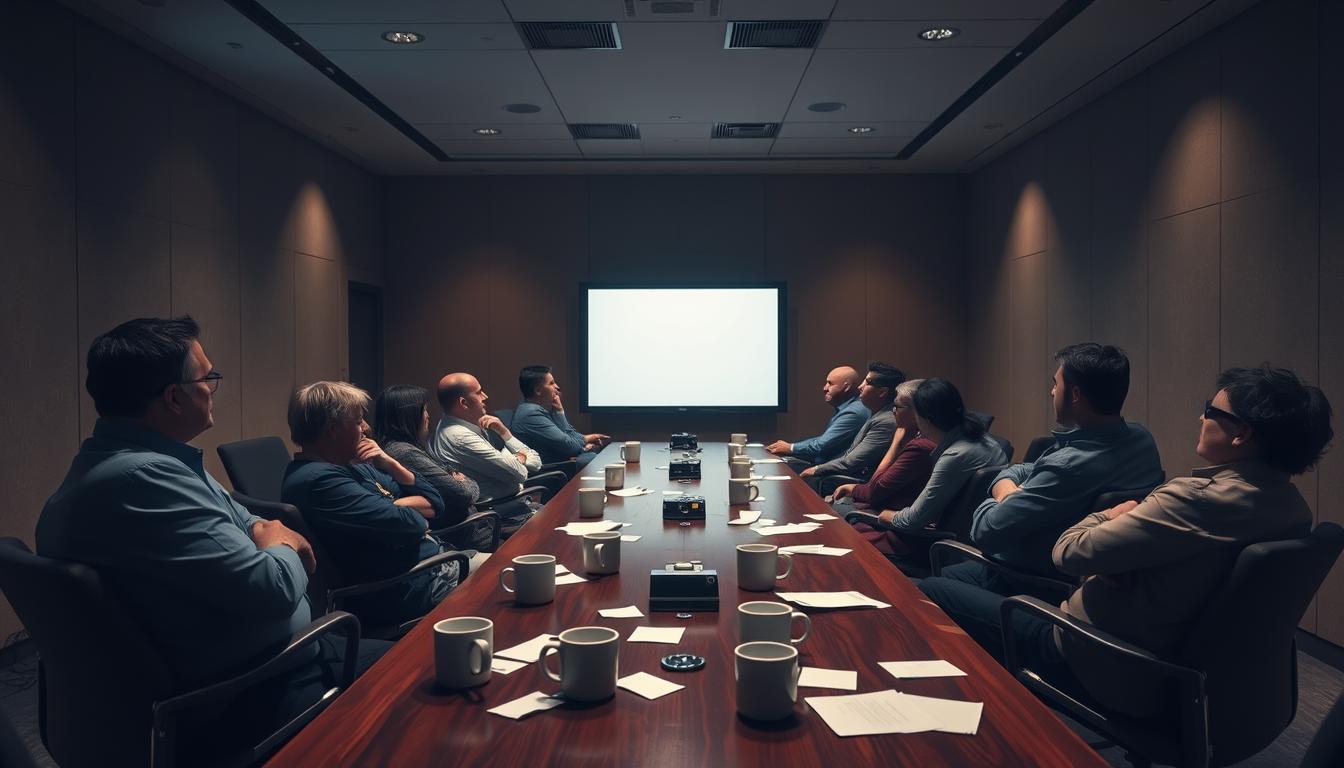The need to fix meeting bloat is more important than ever in today’s fast-paced workplace. Workers often find themselves in long, unproductive meetings. This stops them from doing their job well. To make meetings better, companies need to find and fix what’s wrong with how they do them now.
It’s not just about having shorter meetings. It’s about getting back hours for work that matters. We will look into meeting bloat and how to fight it. By doing this, we make sure every meeting is useful and values everyone’s time.
The Hidden Costs of Unproductive Meetings
Unproductive meetings are a big worry in today’s workplace. They lead to lots of wasted time and resources. By understanding what makes meetings unproductive, companies can improve and make their teams more productive.
Understanding Meeting Bloat
Meeting bloat happens when meetings are packed with too many topics and people. This stops good conversation. Some reasons for this include too many things to talk about and too many people there.
- Overstuffed agendas that dilute focus.
- A high number of attendees, which can lead to a lack of engagement.
Trying to talk about lots of things at once can make meetings useless. These meetings don’t help with making good decisions. This slows down how much work gets done.
The Impact on Employee Productivity
Bad meetings affect the whole company. Workers find themselves stuck in meetings instead of doing their main jobs. This makes them less productive. Companies need to see how this hurts them. It’s key to making sure operations are smooth and workers are enthusiastic.
Identifying the Signs of Meeting Bloat
Noticing signs of meeting bloat can change how groups use their time and resources. A big sign is too many topics on the agenda. This leaves people feeling overwhelmed and stops good discussions. When there’s a lot to cover in small time, it’s hard for everyone to join in well. This situation makes it hard to prepare and often pushes decisions back instead of solving them.
Overstuffed Agendas
Too many items on the agenda is a big sign of meeting bloat. People end up trying to cover too much, leading to shallow talks. It’s key to have priorities so important issues get the focus they need. Without this, meetings can turn into messy talks without solving much.
Inadequate Participation and Engagement
When people aren’t joining in, it’s another sign of meeting bloat. Too many topics can make attendees check out or feel rushed. This not only lowers morale but also the value of discussions. It’s important to keep everyone involved so they feel like their ideas matter.
Creating a Clear Meeting Agenda
A well-structured meeting agenda acts as the core of productive meetings. It focuses on setting clear objectives. This makes sure everyone knows what needs to be done during the meeting. This approach leads to better prep and keeps discussions on track and aimed at the goals.
Setting Clear Objectives and Expectations
Having clear objectives is key for effective meetings. When each meeting has a clear purpose and reachable goals, people come ready to focus. This leads to more effective talks, making the team aim for real results, not just talk. To make your meeting agenda work well, think about:
- Define the main goals before making the meeting agenda.
- Include important topics that match those goals.
- Make clear what you want to achieve for each topic.
Sharing the Agenda in Advance
Sharing the meeting agenda ahead of time lets people get ready. This way, attendees bring useful ideas and everyone knows what to do. A shared agenda makes discussions sharper and helps hit the meeting’s goals. Make sure to share it a few days early, so everyone can come prepared.
The Importance of Right Participants
Productive meetings need the right people. When you bring in the needed attendees, you create a team effort. This cuts down on unnecessary meeting time.
Enforcing the Two Pizza Rule
Keeping the meeting small is key to staying focused. The Two Pizza Rule suggests a meeting size that two pizzas can feed. This keeps everyone involved and prevents too many similar ideas, leading to smarter choices.
Evaluating Who Truly Needs to Attend
Choosing the right attendees is crucial. Only those who add value should come. This ensures everyone plays a part and makes the meeting more effective.
Fix Meeting Bloat
Making meetings more efficient boosts a team’s overall productivity. Applying smart strategies helps everyone get more done. The Knuffke Meeting Protocol is a structured way to make meetings matter and stay on track.
Implementing the Knuffke Meeting Protocol
The Knuffke Meeting Protocol tackles the issue of ineffective meetings. It starts with setting aside time to go over important materials. Then, it moves to focused discussions, making sure talks stick to the main goals. Ending meetings by clearly defining the next steps is key. This approach reduces wasted time in meetings, making them more valuable for all participants.
Adjusting Agenda Items Based on Priorities
Making meetings better also means sorting agenda items by their importance. Evaluate how each item fits with team objectives. This way, discussions stay on important topics, preventing off-topic drift. Such a tactic is pivotal in addressing meeting bloat, making every meeting count.
Strategies for Efficient Meetings
To have efficient meetings, managing time well is key. By using smart strategies, groups can do more and waste less time. Meetings that don’t drag on keep everyone involved and make the meeting more effective.
Limiting Meeting Duration
Keeping meetings short is vital for efficiency. Understanding that work expands to fill available time, as Parkinson’s Law says, is important. Always try to end meetings early if you can. This gives people more time for their work and makes them feel more in control.
Encouraging Pre-meeting Preparation
Preparing before meetings helps use time better. If everyone brings useful info and ideas, the discussion will be on point and valuable. Sending agendas ahead of time makes for deeper thought and better input from all.
Interrupting Multitasking During Meetings
To make meetings better, it’s vital to stop people from doing many things at once. Setting clear rules helps reduce distractions. This makes sure everyone works well together.
Establishing Ground Rules
Leaders need to tell everyone what’s expected in meetings. Some main rules are:
- Leaving mobile devices behind or putting them on silent mode.
- Prioritizing active participation and engagement during discussions.
- Encouraging attendees to share thoughts and insights openly.
These rules help stop multitasking and remind everyone why they’re there. Understanding these expectations lets everyone aim for a common goal.
Utilizing Digital Tools for Collaboration
Using online tools can help keep everyone focused. Tools like Zoom, Microsoft Teams, or Slack let people take part without getting sidetracked. Sharing screens and using documents together keeps talks directed and tidy.
Choosing tools that keep notifications low helps everyone focus more. This way, teams can stick to what’s important in the meeting.
The Role of Feedback in Improving Meetings
It’s key to get insightful feedback from those in meetings to make them better. Knowing how satisfied people are helps teams do well and keeps meetings on track. By regularly checking what works and what doesn’t, meetings become more targeted and relevant.
Regularly Surveying Participant Satisfaction
Using surveys is a smart way to learn about meeting experiences. By asking attendees often, you figure out what they like and what can be better. This lets everyone share their ideas and suggest improvements, making future meetings better.
Adapting Based on Team Needs
Adapting meetings to what the team needs improves things. Listening to feedback means changes can be made to what’s discussed, how long meetings last, and how they’re run. Being willing to change encourages teamwork and makes everyone happier about meetings.
Promoting Meeting-Free Days for Better Focus
Many companies now choose certain days to have no meetings. This lets staff dive into work needing lots of focus without breaks. Such a change is great for making teams more productive.
Designating Specific Days for Deep Work
Companies may pick a day, like “No Meeting Wednesdays,” for serious work time. This break from meetings gives everyone uninterrupted time to focus and lowers stress. With this setup, employees use their time and energy better, making the quality of work better.
Advantages of Extended Project Blocks
Days without meetings give teams more time to deeply focus on their tasks. This helps bring out more creativity and new ideas since there are fewer interruptions. Over time, this focused work clearly shows its benefits, highlighting the need to plan work schedules smartly.

Conclusion
It’s essential to tackle meeting bloat to boost productivity at work. By fixing meeting bloat, we save valuable time and make workers more involved. When each meeting has a clear purpose and everyone’s role matters, companies do better.
Good meetings come from careful planning and having a strong agenda. These help teams work together towards common goals. Applying these ideas helps create a culture where meetings are useful, improving performance and making employees happier.
When we avoid useless meetings, we give time back for important work. This helps businesses do well because everyone is focusing on what matters. Being dedicated to making meetings better will surely increase productivity for all teams.



